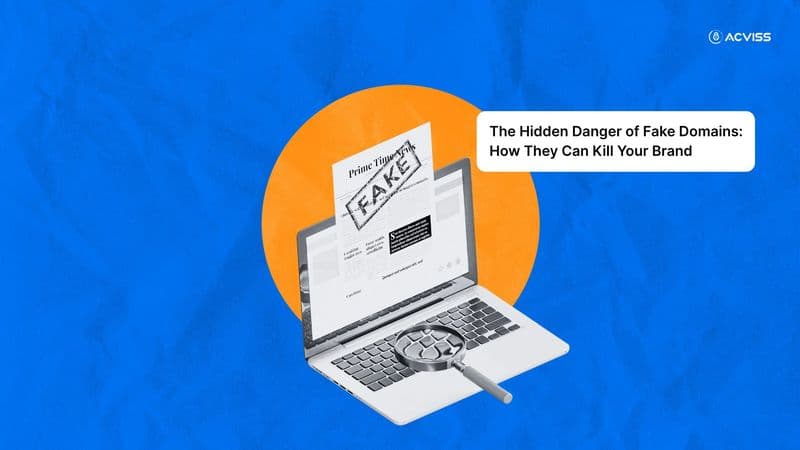The Hidden Danger of Fake Domains: How They Can Kill Your Brand

Have you ever bought a 'Bilseri' instead of the popular brand 'Bisleri?' Have you purchased a product and then realized that it has typographical errors in the packaging? Have you seen product pages using the brand colours of a well-known brand?
Has that ever made you wonder if the two products are from sister companies or if you have been duped? Duplicating renowned brand products is a common practice. With the virtual world re-inventing the marketplace, the threat of duplication has become complex. Along with brand identity, counterfeiters are duplicating domain names to dupe buyers.
The Typoglycemia Effect and Fake Domain Names
Websites, emails, and ad campaigns are a platform for brands to communicate with their buyers. The online brand presence builds its image. It is a medium to tell customers the values of the organization. For the customers, websites and emails are a source of information communicating the best deals! Given the importance of online platforms for driving revenue, they are a coveted target of cybercriminals.
Fake or look-alike domain names confuse buyers into believing that the web page they are visiting is original. Fake domain names are very similar to the original ones. The human mind is unable to distinguish slight differences. So if you happen to see a 'fipkart.com,' you are likely to read it as the famous 'Flipkart.com.' People tend to look for the whole, instead of parts. Thus, we read words instead of letters. The tendency of the human mind to comprehend scrambled words unconsciously is the typoglycemia effect.
How Do Fake Domain Names Impact a Brand?

A brand's reputation offers a competitive edge in a challenging market. During economic churns, it is the brand image that helps organizations stay afloat. Brand image is the intangible asset building on trust. Fake domain names are a threat to the brand's intangible as well as intangible ways.
1. Revenue loss for ads:
Paid ads are essential for digital marketing campaigns. Fake domain names can lead novice market experts to host their ads on fake websites. The ad campaigns hosted on fake websites will result in poor traffic. Also, the ads may show up alongside objectionable content, turning customers away.
2. Loss of communication channel for offers:
Lucrative offers keep your customers engaged and loyal. Emails and banner ads on websites are valuable tools for communicating the best deals to regular customers. If look-alike email IDs spam your customers, they may be sceptical of clicking on any of your future emails.
3. Data privacy and scammers ruin customer experience:
Building trust is a long and arduous task. Online shopping requires users to provide their bank and personal details. Fake and look-alike websites scam customers and can hack their accounts. Customers who fall prey to such cyber crimes may never trust the brand again. The negative customer experience can lead to revenue loss for the company.
4. Substandard and spurious products:
Spoof URLs can be hard to detect. Other than phishing, spamming, and hacking users, these websites may be a source for selling counterfeit products. The websites may offer lucrative prices to lure unsuspecting people. But the products they sell can be spurious and unsafe for customers.
How to Identify Fake Domains Targeting Your Brand

Fake domains can mislead consumers, sell counterfeit products, or steal sensitive information. Here are five ways to quickly spot fake domains targeting your brand:
Look for Misspelled or Similar Domain Names:Fake domains often closely resemble your brand name but with slight variations or typos, like adding extra characters or swapping letters (e.g., www.google.com instead of www.gougle.com). This is known as typosquatting.
Check for Unusual Domain Extensions: While legitimate brands use popular domain extensions like .com, .org, or country-specific TLDs, counterfeit sites often use less common extensions such as .co, .xyz, or others that don’t align with your business or location.
Analyze Website Design and Content: Fake domains typically have poor website design, broken links, and inconsistent branding. Look for incorrect logos, low-quality images, or grammar and spelling errors that aren’t present on your official site.
Verify Contact Information and SSL Certificates:Counterfeit websites often lack professional contact details or use generic, untraceable information. Ensure your brand’s sites have valid contact info and secure SSL certificates (look for “HTTPS” and a padlock icon in the URL).
Check Domain Ownership with WHOIS Tools: You can use WHOIS tools to check the domain’s registration details. Fake domains often have hidden or unrelated ownership information, unlike your official site, which should list a verified entity or business name.
Happy Customers, Healthy Growth
A customer who feels duped is unlikely to trust the brand again. Even if the customer may be angry with the scam website owner, the original band pays the price. The sense of betrayal gets projected on the original brand. Making fake URLs is cheap and easy. There are 1000s of fake websites going live every day. However, with fraud protection technology, brands can safeguard themselves from online threats and protect their customers. Get in touch with us to learn more about online brand protection and how to implement solutions to secure your online presence.

Frequently Asked Questions (FAQs)
1. How can social media verification help in identifying authentic brand channels?
A: Social media platforms' verification badges help consumers distinguish official brand accounts from impersonators. Look for blue checkmarks and verified badges on platforms like Instagram, Twitter, and Facebook to ensure you're following legitimate brand channels.
2. What role do mobile apps play in counterfeit prevention?
A: Official brand mobile apps provide secure shopping environments and often include authentication features like QR code scanners to verify genuine products. Always download apps from authorized app stores and check developer credentials.
3. How do international trademark laws protect against domain impersonation?
A: International trademark laws allow brands to take legal action against domain squatters and impersonators across borders. The Uniform Domain Name Dispute Resolution Policy (UDRP) provides a framework for resolving domain disputes globally.
4. What emerging technologies besides blockchain can help combat counterfeiting?
A: Advanced technologies like AI-powered image recognition, NFC tags, and quantum dots can help authenticate products. These solutions can identify subtle differences between genuine and counterfeit items that humans might miss.
5. How can consumers report suspected fake domains or counterfeit products?
A: Consumers can report suspicious domains to domain registrars, cyber crime units, and brand protection teams. Many brands have dedicated hotlines or web forms for reporting counterfeits, helping protect other consumers.